June 17, 2025 | 13:45 GMT +7
June 17, 2025 | 13:45 GMT +7
Hotline: 0913.378.918
June 17, 2025 | 13:45 GMT +7
Hotline: 0913.378.918
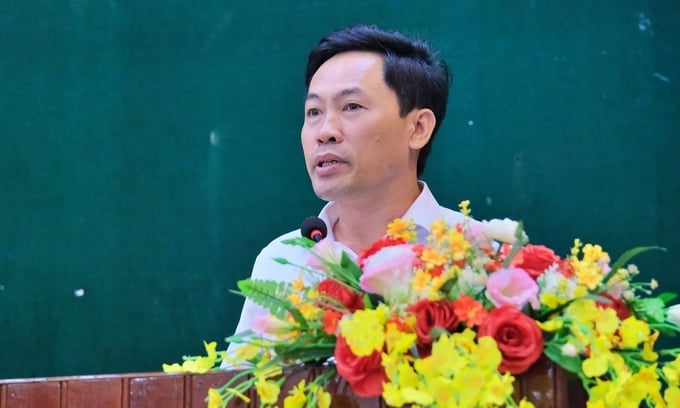
Nguyen Van Huu, Deputy Director of Nam Dinh Province's Department of Agriculture and Rural Development, giving a speech at the signing ceremony. Photo: Bao Thang.
The International Rice Research Institute (IRRI), in collaboration with Nam Dinh Province's Department of Agriculture and Rural Development, organized a ceremony on August 20 in Yen Cuong Commune, Y Yen District, Nam Dinh Province, to launch a model for processing straw into organic fertilizer. Additionally, the model aims to provide training on the processing technology for the local farmers.
Nguyen Van Hieu, a specialist from Tien Giang University, noted that rice farmers nationwide tend to prioritize yield and productivity over other factors. This approach is incompatible with current development trends, as high yields typically require the increased use of seeds and fertilizers, which may negatively impact sustainable production value.
"The agricultural sector is gradually shifting towards agricultural economics. Excessive use of seeds and fertilizers can have long-term consequences," Hieu explained.
The IRRI consultant suggested that farmers start with the correct seed and fertilizer usage while implementing measures to recycle straw, a significant byproduct of rice production, to optimize economic value.
Vietnamese farmers traditionally burn straw in the fields, which results in environmental pollution and health issues. Alternatively, IRRI advises farmers to compost straw into organic fertilizer, which can be used as a soil supplement similar to chemical fertilizers. In addition to generating additional value from straw, composting straw as organic fertilizer also helps reduce greenhouse gas emissions.
IRRI has developed and transferred the technology for composting straw using automated mixers, which boasts a processing capacity of 138 to 300 cubic meters of straw per mixing session. The composting process spans approximately 45 days, half the time required by traditional practices such as manual composting or using loaders.
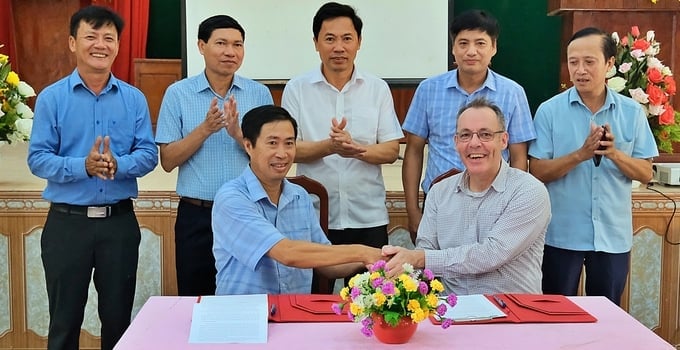
The signing ceremony between IRRI and Nam Cuong Agricultural Production, Business, and Service Cooperative. Photo: Bao Thang.
For effective composting, farmers must prepare composting beds, mix and turn the material, apply microbial inoculants, cover the mixture with tarps, and regularly monitor temperature and pH levels. Subsequently, a second round of mixing is required 10 to 15 days prior to the final product.
In practice, Vietnamese farmers can also add cow manure during the composting process at a ratio of 40% or add nitrogen-rich soil. An optimal compost mixture typically consists of 60% straw, 30% cow manure, and 10% soil. IRRI recommends applying additional microbial inoculants, using 1 liter as a base inoculant mixed with 1 kilogram of molasses and 18 liters of water. Subsequently, the mixture should be composted for 7 days to produce 20 liters of secondary inoculant. Furthermore, each liter of secondary inoculant should be diluted with 10 liters of water and applied to approximately 250 kilograms of material.
"Farmers should note the temperature and humidity during the composting process. The ideal temperature ranges between 50 and 70 degrees Celsius, whereas the humidity should remain between 50 and 60%. Typically, the temperature of the composting bed decreases after being covered with a tarp and then rises after each round of mixing," added Hieu.
After 45 days from the first round of mixing, the organic fertilizer will be ready for use. A high-quality final product has a C/N ratio of 13 to 14.5 and a pH level of 6.8 to 7.2. The fertilizer should then be spread out on a large surface or dried in the sun to reduce moisture before being processed into pellets and stored.

The training program drew significant interest from the residents of Yen Cuong Commune, Yen District. Photo: Bao Thang.
Following the theoretical presentation, IRRI experts demonstrated mechanized technology for producing organic fertilizer from straw at Nam Cuong Agricultural Production, Business, and Service Cooperative (Yen Cuong Commune, Y Yen District). The program also covered the construction of composting beds and the operation of automated mixing machines.
Nguyen Van Du, Director of Nam Cuong Cooperative, expressed his enthusiasm at receiving the automated compost mixing machine from the project for a duration two years. "I, along with other cooperative members, will ensure its effective operation and share our experiences with neighboring communities," he commented.
During the program, Nguyen Van Huu, Deputy Director of Nam Dinh Province's Department of Agriculture and Rural Development, noted that the province currently houses approximately 73,000 hectares of rice production area, with an annual rice output of nearly 900,000 tons. Consequently, the province produces a substantial volume of straw and agricultural byproducts.
Nam Dinh Province is one of six locations selected for the Fertilize Right Project, led and funded by the U.S. Department of Agriculture (USDA) and managed by the Department of Plant Protection (Ministry of Agriculture and Rural Development).
"The province has gradually shifted from inorganic to organic fertilizers within the last few years, as evidenced by the development of various product supply chains," Deputy Director Huu highlighted, adding that farmers have recognized the impacts of excessive inorganic fertilizer use, such as soil degradation, impaired plant growth, and reduced resilience.
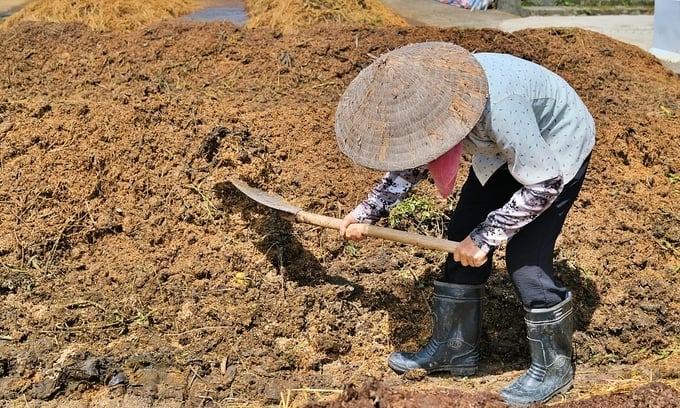
Local farmers assessing the quality of the mixed product. Photo: Bao Thang.
The province currently implements several policies to encourage the use of organic fertilizers through training sessions aimed at changing farmers' attitudes towards fertilizer use and enhancing methods for processing straw and agricultural byproducts.
Deputy Director Huu praised the recycling of straw into fertilizer as an "excellent model" and expressed hope that the success of the model will promote the use of organic fertilizers among farmers, thereby creating a closed-loop production system and advancing towards sustainable and green agriculture.
"Our collaboration with IRRI will provide the residents of Nam Dinh Province with the opportunity to improve their income and protect the environment. On behalf of the provincial agricultural sector, I pledge to facilitate the project's implementation. I hope that, following Yen Cuong, many other communes will also have the chance to produce organic fertilizer from straw," Deputy Director Huu emphasized.
Robert Caudwell, Country Representative for Laos, Myanmar, and Vietnam at IRRI, added that the event on August 20 is part of a pilot and expansion effort to promote the processing of straw into organic fertilizer. The project aims to raise awareness among farmers and reduce harmful practices such as straw burning or burying in wet fields, which contribute to greenhouse gas emissions.
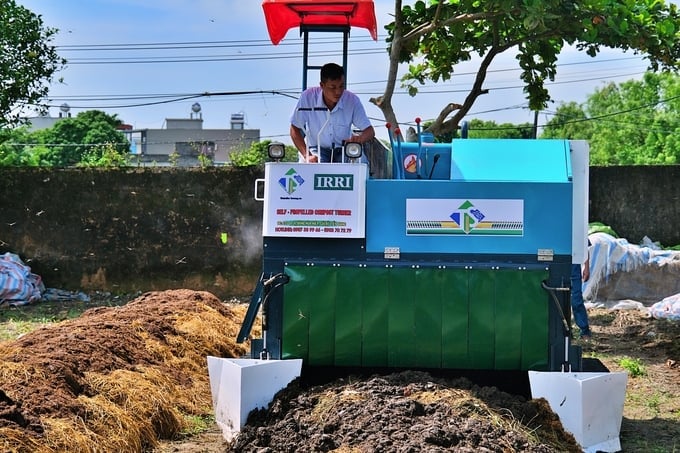
IRRI demonstrating the automated mixing machine during the program. Photo: Bao Thang.
According to Caudwell, IRRI has researched straw processing technology for several years; and collaborated with various agencies within the Ministry of Agriculture and Rural Development to implement the technology in the Mekong Delta. More recently, IRRI introduced this technology in Vinh Thanh District, Can Tho City in June 2024.
IRRI representatives noted that this new technology addresses both quality and cost challenges. The straw is uniformly mixed at an optimal ratio, significantly reducing labor time for farmers. The decomposition process, which spans 45 days, has also been optimized.
"Producing fertilizer from straw has the potential to change farmers' perceptions regarding this byproduct. Consequently, it can motivate farmers to actively collect straw immediately after harvest," Caudwell emphasized.
The Fertilize Right Project consists of three components: developing technologies and tools for effective fertilizer use in rice production; enhancing communication capacity among stakeholders; and monitoring and evaluating project implementation.
The project will run for four years, from 2024 to 2027, with technical support from USDA, IRRI, and Vietnamese scientists. It will be implemented in six provinces: Hai Duong, Thai Binh, Nam Dinh, Can Tho, Soc Trang, and Dong Thap.
Translated by Nguyen Hai Long
![Turning wind and rain into action: [5] Hue applies modern technology in disaster forecasting](https://t.ex-cdn.com/nongnghiepmoitruong.vn/608w/files/news/2025/06/17/z6704423696987_15fd32ffc26d590d204d520c9dac6786-nongnghiep-093938.jpg)
(VAN) In Hue city, modern technology has recently been applied in meteorological and hydrological forecasting and warning, helping to reduce the damage caused by natural disasters.

(VAN) A cutting-edge farming technique being implemented on an experimental ranch in Arizona's Sonoran Desert has already saved a billion gallons of water over five years, according to Civil Eats.

(VAN) Poultry and pig production and the environment can be boosted through enhanced water technology, according to new research.
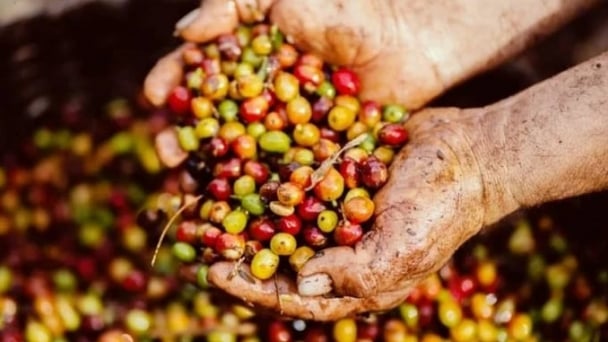
(VAN) Coffee prices on June 16, 2025 are unchanged. In Vietnam, local trading prices are holding steady, ranging around VND 112,000 – VND 112,500/kg.
![Turning wind and rain into action: [4] Bringing climate bulletins to remote and isolated areas](https://t.ex-cdn.com/nongnghiepmoitruong.vn/608w/files/linhnhp/2025/06/14/1152-z6704423696987_15fd32ffc26d590d204d520c9dac6786-nongnghiep-151141.jpg)
(VAN) The Vietnam Agriculture and Nature Newspaper interviewed Mr. Vu Thai Truong, Acting Head of Climate Change and Environment at UNDP Vietnam, to gain deeper insight into how climate bulletins are delivered to farmers.

(VAN) In Tien Giang, a high-tech shrimp farm has developed a distinctive energy-saving farming model that has yielded promising results.
![Turning wind and rain into action: [3] 300.000 farmers benefit from agro-climatic bulletins](https://t.ex-cdn.com/nongnghiepmoitruong.vn/608w/files/news/2025/06/12/e5a48259d6a262fc3bb3-nongnghiep-125122.jpg)
(VAN) The agro-climatic bulletin has become a valuable tool for farmers in the Mekong Delta. After more than five years of implementation, the initiative is gradually being expanded nationwide.